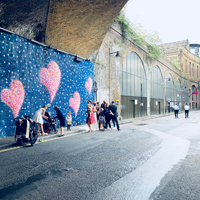A Year of Nicaraguan Festivals and Celebrations
Summary: From San Silvestre Papa in January to Tulululu in May, Nicaragua has more than 200 festivals each year. Casey Callais highlights the best festivals throughout the year.
Festivals are fascinating showcases of Nicaraguan culture and tradition and every visitor should see at least one before they leave. With more than two hundred going on it is hard to choose which to experience, so let's break it down into the best of the best for each month of the year.
San Silvestre Papa
If you aren't going to the beach or taking today as a recovery day from the party last night, head out to Catarina on the first for Nicaragua's number one can't miss festival in January.
Have you ever seen a bulldeer? It's a mix between (you guessed it) a bull and a deer. They call it Torovenado in Spanish, we call it one of the strangest festivals we have seen. Especially considering it is to celebrate the good Saint Silvester.
The Torovenado parade is when hundreds of masked revelers march (perhaps crawl or creep or slither would be a better word) dressed as a zoo of jungle animals, devils and demons, caricatures of famous politicians and, well, anything goes. This festival brings out the best in Nicaraguan traditions with the Torovenado as well as other characters such as the Gigantona, the Viejo and Vieja and the little indians.
People start to gather in the morning when typical Nicaraguan dishes such as Nacatamales, Indio Viejo and Rosquillas are served. If you have ever wanted to eat festival food out of a banana leaf, this is the place to be. About noon is when the first march starts; it the official Saint part of the festival. It is when the devout followers of San Silvestre Papa gather around the statue of the saint outside of the church and shower him with offerings of fruit and flowers. He doesn't eat much but that doesn't stop the faithful from tying their offerings on sticks that reach over to the figure. It is the thought that counts. The procession of people, offerings and the saint make their way through the quaint village of Catarina with the Torovenado trailing close behind.
Catarina is located just a half-hour outside of Managua. The festival started last year and ends today, the first of January.
International Poetry Festival
Nicaragua loves their poetry and this is the largest poetry events in all of Central America. Over 50 countries are expected to be represented by hundred of poets during this week-long celebration of the beauty of the written and spoken word in the rustic colonial city of Granada. It would have brought tears to the eyes of Ruben Dario.
Every year the work of a prominent Nicaraguan poet is featured. If you have ever wanted to rub shoulders with the heavyweights of Nica literature, this is the place to be. Throughout the week there are readings scheduled in different churches, markets, city streets, schools, even the police station. The event is so popular that readings spill over into neighboring pueblos of Masaya, Diria, Masatepe, all the way up to Leon. It's a definitely worth exploring to not just get a feel of the Nicaraguan poetry scene, but also the culture of the villages.
In addition to poetry recitals there is also a book fair and an artists fair as well as a “cultural identity carnival” that features traditional Nicarauan dancing and cultural manifestations like the Gigantona and her little indigenous suitor, the Inano Cabezon (big-headed midget).
Head to Granada in February during the week of the 15th – 22nd to experience or share in the celebration. The city thanks you. And as poets at heart we say, “De nada, Granada.”
Check out the festival's official website for more information: www.festivalpoesianicaragua.com
San Lazaro
 Every dog has its day. That is definitely true in Masaya on the 22nd of March when the dogs play dress up in honor of San Lazaro.
Every dog has its day. That is definitely true in Masaya on the 22nd of March when the dogs play dress up in honor of San Lazaro.
If you remember from your Catholic bible study, dogs licked the sores of Lazarus the beggar and he was miraculously cured of his ailment (sores eventually showed up on the dogs who were later killed by the local cats. There is a special place in doggie hell for Lazarus). Today San Lazaro is honored by residents who bring their pups dressed in their Halloween best to the Iglesia de Magdalena to be blessed by the local bishop. Not only does he bless them but he seals the deal by pouring an indigenous brew known as chingastuda on their backs.
All kind of costumed pooches wearing all kinds of costumes are walked, carried and dragged to the church. The church will be filled with people trying to either get their pets blessed or get a look at the lucky pups who have to go through the ordeal. There is also a small fair and market, as well as the opportunity to try some backwoods local dishes (iguana egg stew, anyone? Anyone?).
Get to Masaya in the morning and take a taxi to the church in Monimbo. And don't forget your camera!
Chaining of the Judases
The best celebrations in April are for the biggest event going on. Easter. Semana Santa is the week leading up to the big holiday, and out of the hundreds of celebrations going on one of our favorites is in the village of Masatepe on Good Friday. That is when the entire town turns out to watch the hooded crusaders find and capture the roaming Judases, then drag them around town in chains.
There are about two dozen crusading groups of masked men, each group sporting their own style of uniform but generally keeping with the bright, frilly space hat theme, who are on the hunt for Jesus' betrayer. When they find him (and it isn't hard since there are at least one per group), they hold him down, hook their chains around his belt, throw the chains over their shoulders and start pulling in all directions. Judas is lifted off the ground and carried by the chains through the streets.
It is quite a sight to see and exhilarating to watch. Expect loads of people there as well but very, very few tourists. This is one of the best-kept secrets of all the Nicaraguan festivals!
Tulululu
Whatatatat's thatatatat?
The Tulululu is the closing parade celebrating Mayaya, the Caribbean coast's goddess of fertility. It is also the name of the dance that goes on for blocks during the festival, but more on that later.
The entire month of May is devoted to the Maypole celebrations in honor of Mayaya and the May rains she brings. On the last day of the month, starting right after the sun goes down, the people of Bluefields gather in the Old Bank neighborhood with their marching band and ribboned maypole tree. They start dancing in the old Caribbean maypole style around the tree and start the slow march across town to Cotton Tree neighborhood.
It is a very organic, almost disorganized event. People join up at every block until there are thousands of revelers and dozens of maypole trees shaking their way down the road. When there are enough people the Tulululu dance begins, with tulululu chains stretching for blocks.
The party goes well into the night with the parade ending and the concerts beginning. Live music by local groups and the ever-popular Caribbean Taste belting out maypole and reggae favorites.
San Juan Bautista
Sword fighting in the streets. Actually, it would be better described as mutual whipping with homemade sabers made from the penises of bulls. This is how they honor their saint in San Juan de Oriente during the festival held between the 22nd and 25th of June.
The origins of this strange tradition stem from the local indigenous submitting to the mighty Spanish sword. To show San Juan the degree of faith they have, they fight with their own homemade swords believing San Juan will protect them from harm(not even San Juan could save them from real swords). While no death from a penis beating has been recorded (thanks San Juan!), it is possible that the liquid faith of St. Rum keeps them from feeling pain. But boy does it leave a mark!
During the main day of the festival the sober revelers who aren't busy with the mad penis sword whipping get together and parade through the streets carrying a giant crown of flowers and the figure of the saint.
19th of July – Sandinista Day
Today is the anniversary of the end of the Sandinista revolution when the Somoza regime gave up power in 1979. Every village, town and city is celebrating today with the largest celebration in the capital city of Managua.
People start gathering in the Plaza de Revolucion in the late afternoon to hear the president speak but he isn't the only one. It's a who's who of politicians from revolutionary states who take the podium to speak to the hundreds of thousands of people. Last year we saw the president of Venezuela, ex presidents from Honduras, Ecuador, Cuban politicians and the Pulitzer peace prize winner from Guatemala, Rigoberta Menchu.
The event goes on until after the sun goes down and finishes with a grand fireworks display and a long wait for a taxi to return home.
Crab Soup Festival
The owning of slaves is sooo 1820's. To commemorate their emancipation, the Corn Islands march, dance and eat crab soup on the 27th (Big Island) and the 29th (Little Island). And what a party it is.
First of all, it's the Corn Islands. White sand beaches, crystal blue water, Caribbean English speaking population… it's a completely different Nicaragua. And this Nicaragua has their own way of celebrating. It starts about 5am with a band in the back of a truck making the rounds around the island to wake everyone up. Nobody wants to miss the emancipation parade that starts soon after.
When lunch time draws near, people meet up in Southend to watch performances of local dance groups, the greasy pole competition, play Kitty Alley and of course eat the crab soup!
The little island's celebration happens two days later on the 29th; rumor has it that's how long it took islanders to sober up and inform their neighbors they were no longer bound by the chains of slavery.
San Jeronimo
The last day of the month is the kick off of the longest festival in Nicaragua, the San Jeronimo celebrations of Masaya. Today is the day the little big saint leaves the dark confines of the church and is carried around on the shoulders of his faithful followers throughout the streets of the village. And if that was all it would hardly warrant making it onto our list. Luckily, there is more.
Following the saint is the parade of the Torovenado, even bigger than the one in January. True to the satirical spirit of the indigenous Nicaraguans, the roving parade ranges from magical creatures plucked from local folklore to costumes of local politicians alive and dead, famous and forgotten, as well as enough demons and devils to scare the daylights of any kids who dare go to visit.
It happens during the day and at night there are usually big parties scattered around town. If you are in Nicaragua during this month then you have to go!
Los Aguizotes
Masaya's biggest, scariest festival happens on the last Friday of the month. What is it? It is when the gates of hell open up for a fearsome parade of devils and demons, which this month falls just before Halloween.
Now, when I say, “fearsome parade of devils and demons,” I don't mean a few groups of people dressed in rubber “scream” masks like you might find at the downtown Halloween festival in Anywhere, USA. I mean the demonic hoards of thousands are unleashed upon the streets for one night of… following a marching band.
The name Aguizotes comes from the harbinger of death in local lore, the guis bird. It is a small yellow and white finch with giant horns. The cheep of the guis is a sure sign death is imminent to someone, somewhere in the world.
The Los Aguiozotes festival takes place to remind us all that one day the guis will come cheeping.
Garifuna Day
 The proud Garifuna people are survivors. They survived kidnappings, crossing the Atlantic, shipwrecks, living LOST!-style in the Caribbean, forced migration to the mainland of Honduras and are now thriving on the coasts between Nicaragua and Belize. Theirs is a tale of a magnificent hybrid culture originating in Africa, mixing with Arawak and Miskito and, in Nicaragua, Creole. The 19th of November is the culmination of a week-long celebration of that culture in the capital of the Nicaragua Garinagu, Orinoco.
The proud Garifuna people are survivors. They survived kidnappings, crossing the Atlantic, shipwrecks, living LOST!-style in the Caribbean, forced migration to the mainland of Honduras and are now thriving on the coasts between Nicaragua and Belize. Theirs is a tale of a magnificent hybrid culture originating in Africa, mixing with Arawak and Miskito and, in Nicaragua, Creole. The 19th of November is the culmination of a week-long celebration of that culture in the capital of the Nicaragua Garinagu, Orinoco.
Drums and dancing are the center of this culture. Just before lunch there is a big presentation of local music and dance groups from communities stretching from Tasbapauni to Bluefields. Lunch is a great opportunity to sample traditional Garifuna fare which is based around seafood and cassava and you might get to try deer, gifnut or armadilly if you are feeling adventurous.
But wait, there's more! The climax of the festival happens in the late evening when the punta-rock band puts on a show. This isn't just a couple of local guys with more time than talent, this is the world-famous group Black Men Soul from Honduras. They never fail to impress as the party goes on well past the midnight hour.
Getting to Orinoco on the 19th is half the fun. At about 5:30am a boat filled with about 200 revelers leaves out from the Bluefields wharf, blasting punta music and reggae as it weaves through the jungle rivers.
Get your tickets for the boat from the Garifuna office in Bluefields.
La Gigantona Nocturna
If there is one character that defines Nicaraguan culture it would have to be the Gigantona. She is a giantess, a caricature of the fine Spanish females that the indigenous male population were smitten with. During the dance of the Gigantona you will hear the drums pounding a fast beat while she swings her arms around her ten-foot frame and the narrator shouts humorous sonnets. Accompanying the tall drink of water is a short little brown man with a giant head, the enano cabezon or big-headed midget. His head is large because he is highly intelligent, and he dances around the object of his affection while the poet narrates tales of how he sneakily wins her over.
While you occasionally see La Gigantona and her small procession roaming around in any town from Leon to San Juan, this festival takes place in Masatepe on the 23rd of December starting about 9pm. Get there and plan to stay up late because the Gigantonas don't let the village sleep. The merry bands of revelers are all over town until the big party starts about 3am in the park.
About the Author
 Casey lives in Managua with his wife and kids. He loves showing people what Nicaragua has to offer by guiding trips to see small-town celebrations with Mana-Ahuac Hoy tours and writing travel guides. His most recent publication is the NCX Guide to Festivals and Events in Nicaragua.
Casey lives in Managua with his wife and kids. He loves showing people what Nicaragua has to offer by guiding trips to see small-town celebrations with Mana-Ahuac Hoy tours and writing travel guides. His most recent publication is the NCX Guide to Festivals and Events in Nicaragua.
Additional Information:
- Nicaragua Guide
- Healthcare & Health Insurance in Nicaragua
- Members Talk about Healthcare & Health Insurance in Nicaragua
- Best Places to Live in Nicaragua
- Real Estate in Nicaragua
- Guide to Real Estate in Nicaragua
- Pros & Cons of Living in Nicaragua
- Cost of Living in Nicaragua
- 9 Important Tips about Healthcare for Expats in Nicaragua
- 13 Things to Know Before You Move to Nicaragua
- 5 Best Places to Retire in Nicaragua
- 5 Great Places to Retire in Central America
- 2025 Guide to Living in Nicaragua
- Pros and Cons of Living in Nicaragua 2025
- 2025 Guide to Moving to Nicaragua





